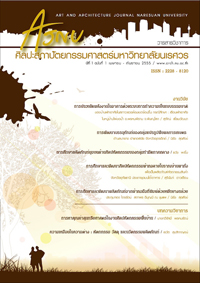การประหยัดพลังงานในอาคารด้วยระบบการทำความเย็นแบบธรรมชาติ ของบ้านพักอาศัยในสภาวะแวดล้อมเขตร้อนชื้น
Main Article Content
Abstract
งานวิจัยในครั้งนี้ เป็นงานวิจัยเชิงประยุกต์ มีวัตถุประสงค์เพื่อศึกษาแนวทางการออกแบบอาคาร การจัดวางผังบริเวณ ศึกษาลักษณะ รูปแบบและรายละเอียดทางสถาปัตยกรรมของเรือนพักอาศัยพื้นถิ่นที่ตั้งอยู่ในสภาวะแวดล้อมเขตร้อน ศึกษาแนวทางการปรับสู่สภาวะน่าสบายด้วยวิธีตามธรรมชาติ ตลอดจนเพื่อแสวงหาแนวทางในการนำภูมิปัญญาและองค์ประกอบทางสถาปัตยกรรมพื้นถิ่น มาประยุกต์ใช้กับการออกแบบพัฒนาสถาปัตยกรรมสมัยใหม่ที่เหมาะสมกับสภาพแวดล้อมในปัจจุบัน โดยมีเรือนพักอาศัยพื้นถิ่นในหมู่บ้านไผ่ขอน้ำ จ.พิษณุโลก เป็นอาคารกรณีศึกษา ผลการวิจัยพบว่าเรือนพักอาศัยในหมู่บ้านไผ่ขอน้ำมีเอกลักษณ์ที่โดดเด่น และแสดงออกถึงความเข้าใจในวิถีแห่งธรรมชาติเป็นอย่างดี หมู่บ้านไผ่ขอน้ำตั้งอยู่ในบริเวณใกล้กับริมแม่น้ำน่าน ซึ่งเป็นแหล่งน้ำขนาดใหญ่ มีต้นไม้ทั้งขนาดเล็กใหญ่มากมายช่วยเพิ่มความเย็นสบายให้กับบรรยากาศโดยรอบ สำหรับลักษณะทางสถาปัตยกรรม ตัวอาคารได้รับการออกแบบให้มีลักษณะที่เปิดโล่ง มีผนังบางเบา มีช่องเปิดมากเพื่อให้ระบายอากาศได้ดี กระแสลมพัดผ่านได้อย่างเต็มที่ ฝาผนังทำด้วยไม้ ที่มีลักษณะโปร่งเบา เช่น ฝาขัดแตะ หรือฝาปะกน ซึ่งมีค่าความเป็นฉนวนสูง ทำให้ไม่เกิดการเก็บกักความร้อนสะสมไว้ที่ผนัง ตัวบ้านได้รับการยกพื้นให้มีใต้ถุนสูง เพื่อหนีน้ำท่วมในฤดูน้ำหลาก ใต้ถุนเรือนมีผืนดินธรรมชาติ และโอ่งน้ำดินเผา ที่มีพื้นผิวที่ค่อนข้างเย็น ช่วยให้อุณหภูมิพื้นผิวเฉลี่ยโดยรอบบริเวณใต้ถุนเรือนลดลงได้มาก ลมสามารถพัดผ่านเข้าสู่ภายในตัวบ้านได้โดยผ่านเข้ามาทางช่องแมวลอด และทางรอยต่อของพื้นไม้กระดาน หลังคาได้รับการออกแบบให้เป็นหลังคาทรงสูง ชายคายื่นยาว เพื่อป้องกันแดดและฝน สมัยก่อนบ้านส่วนใหญ่จะมีหลังคาเป็นทรงจั่ว มุงด้วยแป้นเกล็ดไม้หรือหญ้าแฝก แต่ปัจจุบันบ้านเกือบทุกหลังมีการเปลี่ยนวัสดุมุงหลังคาเป็นสังกะสีไปหมดแล้ว และยังได้ปรับเปลี่ยนหน้าบันของหลังคาใหม่ให้เป็นทรงจั่วที่ต่ำลงมา ทำให้เกิดปัญหาการถ่ายเทความร้อนจากสังกะสีเข้าสู่ภายในบ้านเพิ่มขึ้น นอกจากลักษณะทางสถาปัตยกรรมแล้ว วัฒนธรรม ประเพณี ล้วนแต่แสดงออกถึงความเข้าใจในวิถีธรรมชาติเป็นอย่างดี การแต่งกายของชาวบ้าน จะนิยมสวมเสื้อผ้าที่บางเบา ใส่เสื้อคอกระเช้า เพื่อช่วยระบายความร้อน อาหารการกินเหมาะกับสภาพภูมิอากาศ อาหารพื้นบ้านมีรสชาติค่อนไปทางเผ็ด กินเผ็ด เหงื่อจะออกมากเพื่อปรับลดอุณหภูมิในร่างกายลง กินผัก และดื่มน้ำมากๆ เพื่อช่วยบรรเทาลดเผ็ด และปรับธาตุต่างๆในร่างกายให้สมดุลกับสภาพอากาศที่ร้อน อาหารแบบไทยเป็นอาหารที่มีเส้นใยและกากอาหารมาก ช่วยให้ระบบขับถ่ายทำงานได้ดี ร่างกายได้ขับถ่ายเป็นประจำ ช่วยปรับสมดุลและระบายความร้อนในร่างกายได้เป็นอย่างดี ผู้วิจัยได้นำแนวความคิดในการออกแบบลักษณะทางสถาปัตยกรรมของเรือนพื้นถิ่นมาประยุกต์ใช้ให้สอดคล้องกับการออกแบบบ้านสมัยใหม่ที่เหมาะสมกับสภาพแวดล้อมในปัจจุบัน โดยได้ออกแบบบ้านตัวอย่าง ซึ่งเป็นบ้านที่มีหลังคาทรงสูง ชายคายื่นยาว ป้องกันแดดและฝน เลือกใช้ผนังเบาที่ไม่เก็บสะสมความร้อน ออกแบบให้มีช่องเปิดมากๆ ยกพื้นเรือนให้สูงขึ้น เพื่อช่วยในการระบายอากาศ สร้างแหล่งน้ำขึ้นในบริเวณบ้าน เพื่อประโยชน์ในการช่วยปรับสภาพแวดล้อมให้เย็นลงจากการระเหยของน้ำ ตลอดจนนำความเย็นจากพื้นดินมาใช้ด้วยการถมดินให้สูงและวางแผ่นพื้นบ้านชั้นล่างให้สัมผัสกับผิวดินโดยตรง
Passive Low Energy Cooling of Tropical House
Passive low energy cooling of tropical house is the applied research, aimed to investigate modification strategies for thermal comfort in local houses. Architectural design concepts covering site planning, spatial characteristics (e.g. span, height), the size and placement of openings, roof types, as well as building materials were examined to identify the impact of these physical factors on the residents’ thermal comfort.
The result of this research found that many characteristics of local houses in Paikhonam Village, a study site, could be defined as the passive cooling methods. Natural ventilation system and heat gain prevention were main methods. The house’s characteristics that encouraged air ventilation were open plan, high roof, raised ground floor, and a number of windows which increased fresh air movement. The passive method of heat gain prevention was found in large roof overhangs and the selection of high heat resistant materials such as wood wall and terracotta pavement. The large overhangs provided shading to a house, the surface area exposed to the solar radiation therefore decreased. In addition, wood and terracotta had low capacity in storing and absorbing heat, the use of these materials can therefore protect the building from receiving excess heat.
Unfortunately, modern materials tended to replace these traditional energy-efficient materials. Almost all houses’ roofs in the village were changed from wood shingles to metal sheet, one of the most high thermal conductivity materials. Also, the height of gable roof was lowered in many houses; accelerating the rate of heat transfer. Changes in roof form and roof material significantly increased heat storage and led to the reduction of comfortable temperature within the house. Apart from architectural components, behaviors and life-style were considered as the key factors in achieving thermal comfort. Wearing traditional vest, eating spicy and food vegetable, and regular drinking water all not only helped to release heat from body but also maintained biological equilibrium, resulting in a comfortable feeling. In conclusion, the concept of passive cooling methods found in local houses should be applied in contemporary houses mainly relied on mechanical cooling method that is air conditioning. High roofs with large overhangs, light weight wall with low heat absortion and large area of openings, raised ground floor allowing natural ventilation, and water features in house house surroundings are cooling solutions should be integratively used in order to decrease the electric demand of air conditioning use.


